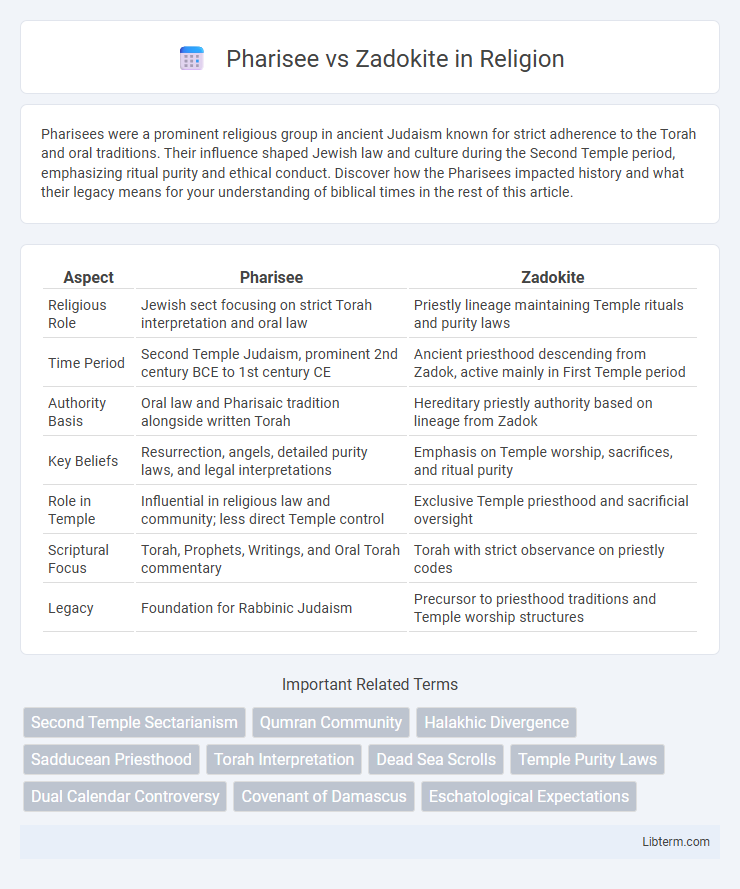Pharisees were a prominent religious group in ancient Judaism known for strict adherence to the Torah and oral traditions. Their influence shaped Jewish law and culture during the Second Temple period, emphasizing ritual purity and ethical conduct. Discover how the Pharisees impacted history and what their legacy means for your understanding of biblical times in the rest of this article.
Table of Comparison
| Aspect | Pharisee | Zadokite |
|---|---|---|
| Religious Role | Jewish sect focusing on strict Torah interpretation and oral law | Priestly lineage maintaining Temple rituals and purity laws |
| Time Period | Second Temple Judaism, prominent 2nd century BCE to 1st century CE | Ancient priesthood descending from Zadok, active mainly in First Temple period |
| Authority Basis | Oral law and Pharisaic tradition alongside written Torah | Hereditary priestly authority based on lineage from Zadok |
| Key Beliefs | Resurrection, angels, detailed purity laws, and legal interpretations | Emphasis on Temple worship, sacrifices, and ritual purity |
| Role in Temple | Influential in religious law and community; less direct Temple control | Exclusive Temple priesthood and sacrificial oversight |
| Scriptural Focus | Torah, Prophets, Writings, and Oral Torah commentary | Torah with strict observance on priestly codes |
| Legacy | Foundation for Rabbinic Judaism | Precursor to priesthood traditions and Temple worship structures |
Introduction to Pharisees and Zadokites
Pharisees were a Jewish sect during the Second Temple period known for strict adherence to the Torah and oral traditions, emphasizing purity laws and beliefs in resurrection. Zadokites were a priestly family descended from Zadok, serving as temple priests and guardians of the Levitical priesthood, maintaining strict ritual purity and temple worship. Both groups played significant roles in Judaic religious and social life, shaping theological and ceremonial practices in ancient Israel.
Historical Origins and Development
The Pharisees emerged during the Second Temple period as a prominent Jewish sect emphasizing strict adherence to the Torah and oral traditions, originating from common people and scribes. The Zadokites traced their lineage to Zadok, the high priest under King Solomon, maintaining a hereditary priestly class focused on Temple rituals and purity laws. Over time, Pharisees influenced Rabbinic Judaism through their interpretative methods, while Zadokites shaped priestly authority until the Temple's destruction in 70 CE.
Core Beliefs and Doctrinal Differences
Pharisees emphasized strict adherence to the Torah and oral traditions, believing in resurrection, angels, and a coming Messiah, while Zadokites maintained a priestly focus on Temple rituals and purity laws without embracing resurrection or extensive oral law. Pharisees advocated for accessibility of religious practice beyond the Temple, promoting synagogues, whereas Zadokites prioritized centralized Temple worship and priestly authority. The doctrinal divide centers on Pharisees' interpretive legalism and eschatological beliefs contrasted with Zadokites' conservative priesthood and ritual exclusivity.
Scriptural Interpretations
Pharisees emphasized oral traditions and strict adherence to the Law of Moses, interpreting Scripture through a lens of ritual purity and legal meticulousness. Zadokites, linked to the priestly lineage from Zadok, focused on temple service and sacrificial rites, grounding their interpretations primarily in priestly authority and Levitical laws. Scriptural interpretations by Pharisees often highlighted moral and ethical applications, while Zadokites upheld temple rituals as central to covenant fidelity.
Role in Second Temple Judaism
Pharisees played a crucial role in Second Temple Judaism by emphasizing oral law, strict observance of purity laws, and adaptability of religious practices among the common people. Zadokites, a priestly lineage descended from Zadok, maintained exclusive control over the Temple priesthood and rituals, ensuring the sanctity and continuity of sacrificial worship. This division underscored the tension between popular religious movements and established priestly authority during the Second Temple period.
Leadership and Community Structure
Pharisees emphasized popular leadership through learned teachers and rabbis who interpreted the Torah for the community, fostering a decentralized structure centered on synagogues and local assemblies. Zadokites upheld a strict priestly hierarchy rooted in the Temple, with leadership confined to the descendants of Zadok, maintaining centralized religious authority and ritual purity. The Pharisaic model promoted broader community participation, while Zadokite leadership reinforced elite control over sacrificial rites and sacerdotal governance.
Relationship with the Sadducees
Pharisees and Zadokites both held influential religious roles in ancient Judaism but maintained distinct theological and political stances that shaped their relationship with the Sadducees. Pharisees emphasized oral law and resurrection, often opposing the Sadducees' strict adherence to written Torah and denial of afterlife concepts, while Zadokites, linked to priestly purity and Temple rituals, shared some priestly authority with the Sadducees but diverged in ritualistic interpretations. The Sadducees, predominantly from the priestly class including Zadokites, often aligned with Zadokite interests, leading to complex partial alliances and repeated conflicts with the Pharisees over law enforcement and Temple practices.
Conflict and Cooperation with Other Jewish Sects
Pharisees and Zadokites frequently clashed over religious authority, with Pharisees emphasizing oral law and popular piety while Zadokites prioritized priestly rituals and Temple purity. Their conflicts influenced Jewish sectarian dynamics, especially regarding interpretations of Torah and Temple practices. Despite tensions, both groups occasionally cooperated in opposition to common threats like Hellenistic influences and Roman occupation.
Influence on Later Jewish Thought
Pharisees significantly shaped later Jewish thought through their emphasis on oral law and adaptability in interpreting Torah, laying foundational principles for Rabbinic Judaism. Zadokites, as priestly elites, influenced the development of Temple worship and priestly traditions, impacting the Levitical framework central to Jewish ritual practice. The contrast between Pharisaic legal innovation and Zadokite priestly authority reflects ongoing tensions that contributed to the diverse theological currents within Judaism.
Legacy and Lasting Impact
Pharisees significantly shaped Jewish religious practices through their emphasis on oral law and adaptability, influencing Rabbinic Judaism and modern Jewish thought. Zadokites contributed a priestly legacy by preserving Temple rituals and priesthood purity, impacting the structure of Jewish worship and priestly lineage claims. Their contrasting legacies reflect enduring debates over religious authority, law interpretation, and communal leadership within Judaism.
Pharisee Infographic

 libterm.com
libterm.com